Consumer expectations are high. They ask for fast, efficient services that are personalized, meet their needs, and pander to anything they want. Don't have it? They'll find someone else. IT service desks, often the first point of contact for users experiencing tech troubles, are under constant pressure to meet these expectations. Enter chatbots - a solution that promises not just efficiency but scalability and cost-effectiveness. But just how pivotal are chatbots to modern IT service desks?
Immediate Response to Queries
One of the standout advantages of chatbots is their ability to provide immediate responses. Unlike humans, chatbots don't need breaks. They can handle multiple queries simultaneously. When a user contacts the service desk with a common issue or question, the chatbot can quickly provide a solution, reducing wait times and enhancing user satisfaction.
Scalability and Cost-effectiveness
Hiring, training, and maintaining a large IT service desk team can be resource-intensive. Chatbots, once set up, can handle a vast volume of queries without additional costs. This scalability ensures that even during peak times or unexpected spikes in requests, service levels remain consistent.
Aiding Human Agents
Chatbots don't aim to replace human agents but to complement them. By handling routine queries and tasks, chatbots free up human agents to deal with more complex issues. They can gather initial information from the user, and when a human agent takes over, they have all the necessary details at their fingertips.
Integration with Broader Systems
When discussing the role of chatbots, it's essential to touch upon how seamlessly they integrate with other tools. Consider reading a Help Desk Software Guide to understand how chatbots can be a part of a broader system, enhancing the entire IT support ecosystem. When integrated properly, chatbots can pull data from various sources to provide more accurate responses or even automate specific tasks.
Data Collection and Analysis
Every interaction with a chatbot is a data point. This data is invaluable in understanding common user issues, peak times for queries and areas for improvement. Analyzing this data can offer insights that streamline operations and predict when specific issues might spike.
LLMs
Modern chatbots employ technologies such as Machine Learning Models (LLMs) to enhance operational efficiency. These LLMs go beyond traditional machine learning. They are designed to absorb vast amounts of data, refining the chatbot's responses more accurately with every user interaction. This constant evolution ensures that the chatbot's understanding deepens, adapting to changing user behaviors and needs.
Furthermore, LLMs can identify patterns and trends that might be missed in traditional models. This ability not only aids in better response formulation but also helps in proactively addressing user queries even before they arise. The integration of LLMs underscores the commitment to ensuring chatbots remain at the forefront of technological innovation in IT service desks, ensuring they continually evolve to provide the best possible user experience.
Chatbots, while not a replacement for the human touch, are becoming an indispensable tool for IT service desks. They offer immediacy, scalability, and multiple other benefits that can transform how IT support is delivered. As technology evolves, it's clear that chatbots will play an even more significant role in shaping the future of IT support.








